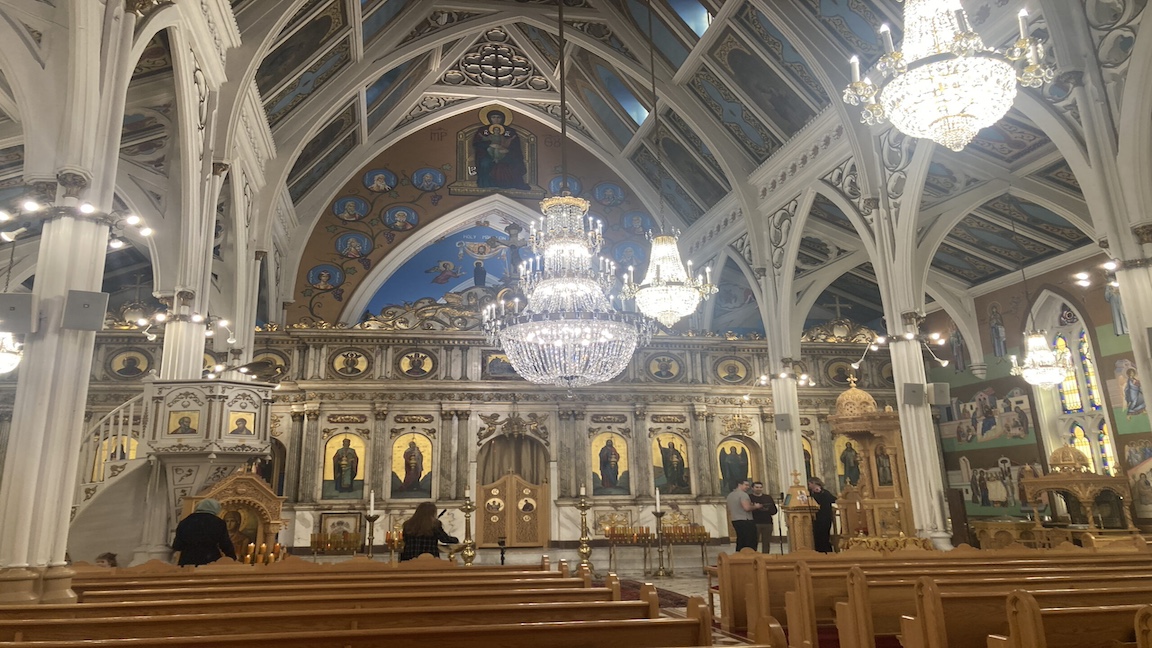
BROOKLYN — The Divine Liturgy at St. Nicholas Antioch Cathedral in Brooklyn on a recent rainy Sunday morning overwhelms the senses. Incense hangs heavily in the air, and the icons are everywhere, painted on the walls and the ceiling. Sacred relics are set aside for viewing. Candles decorate the whole space. There are yellow candles in the back for parishioners to light. The red candles in front of the icons at the front of the sanctuary. There are rows of light wooden pews, but most people are standing. The chanting has already begun to the left side of the nave.
St. Nicholas Antioch Cathedral is located at 355 State Street in Boerum Hill, Brooklyn. It’s an Antiochian Orthodox Church. The stone church was first built as an Episcopal church in the 1850s. It was made in the Gothic style with high arches. It became an Orthodox church in 1920. On Sundays, Matins is sung before Divine Liturgy begins at 10:30.
The liturgical chanters are primarily men, a single woman in their midst. They stand in a circle, surrounding a music stand with a golden cross at the center. Some men have iPads and others have sheets of paper. For the most part, they sing alone. The congregation does not sing along. The chanters go back and forth between English and Arabic. Dressed in shades of navy and black and gray and cream, their voices are deep. “Praise Him. Let everything that has breath praise the Lord,” they sing. As congregants enter the church, the chanters’ words are there to greet them. The chants are responsorial. The priest and the chanters are in conversation, and the congregation are the witnesses.
Among the chanters is George Zain. Five years ago, Zain started taking chanting lessons with a priest. He took lessons once a week for three years. Most of the men in the choir have classically Western backgrounds, but Zain favors the Byzantine style. For him, the Western style is more analytic, but with the Byzantine chanting, he said, there is more room to elaborate. “The beauty is you can play with it more.” He sings words like “Resurrection” and “Light,” and gestures upwards. But other words like “death” and “Hades,” he says, “it’s more chromatic, it’s down here.” The liturgical songs are meant to go beyond understanding, and directly engage your heart. There is a mystical quality to it.
Zain feels keenly his responsibility as a liturgical singer, recognizing he has had times where he would sing the words but his heart wasn’t engaged. He feels strongly that the chanting is best done, not with the most pleasing voice, but with an engaged spirit that feels deeply what they are saying. The purpose of liturgical songs is clear to him: “it’s to transcend the faithful, edify the faithful.”
The songs aren’t something you have to understand. “The musician can still speak to you even if you don’t understand. The text, it can transcend body and soul.” Chanting is a crucial part of the Orthodox service, a service that is all about the senses, according to Zain. The rich incense, the gold, the iconography, the chanting—the body is engaged so that the heart can be reached.
